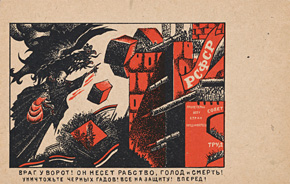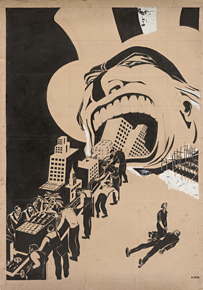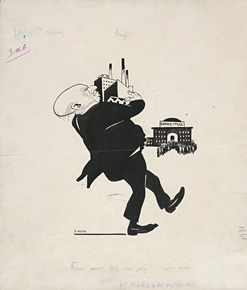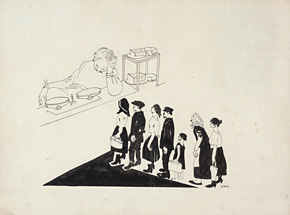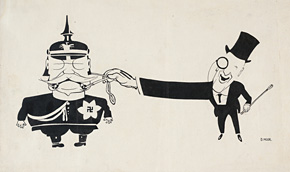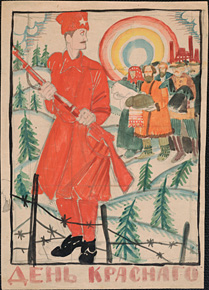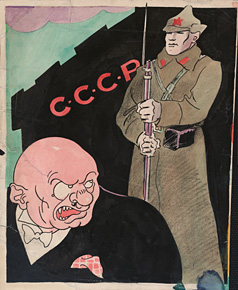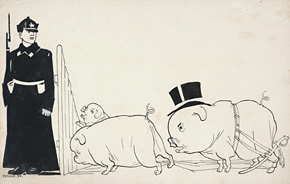

Lětkar | El Lissitzky | Karel Ludwig | Vladimir Luppian | Vladimir Mayakovsky | Iurii Merkulov | DMITRI MOOR | Vadim Nevsky
In the captions artists' titles are in italics, descriptive titles are in roman, and inscriptions taken from the artwork are in quotation marks.
Dimensions are in inches.

KAREL LUDWIG and FRANTIŠEK GROSS
Unknown and Czech: 1909-1985, respectively
"Greetings to the Red Army"
1945
Lithograph
37½ x 24¾

VLADIMIR MAYAKOVSKY
Russian, 1893-1930
ROSTA Window series #42
February 1921
Sowing Campaign: Let's fulfill the decree!
Hand-cut stencils with watercolor pigment
15¾ x 16¼ to 17 x 16¾ each

VLADIMIR MAYAKOVSKY and MIKHAIL CHEREMNYKH
Russian: 1893-1930 and 1890-1962, respectively
ROSTA Window series #81
March 1921
All for Farming Equipment Repair Week!
Hand-cut stencils with watercolor pigment
20½ x 13½ to 21¼ x 14¼ each

IURII MERKULOV and NIKOLAI CHOMOV
Unknown and Ukrainian: 1903-1974, respectively
"Fulfill the five-year plan not in five years, but in four"
1930
Lithograph
21¾ x 13½
DMITRI MOOR
The flamboyant Dmitri Moor may have been the most gifted of the early Soviet graphic artists. Well versed in modern art and folk art traditions, he stumbled into a career in the arts in 1907, when a newspaper editor saw his sketches of Tsarist ministers. His early works were allegorical — with dragons and the figure of death standing in for capitalists and imperialists. Works from the twenties, like his famous recruitment poster entitled Have You Enrolled as a Volunteer? were direct and representational. He was known to fellow artists as the "commissar of propagandistic revolutionary art."
Moor was born in 1883 in Novocherkassk as Dmitri Orlov. He initially signed his drawings "Dor" but changed to "Mor" when a journalist by the same name objected, and finally to "Moor." Moor never received formal artistic training and studied physics, mathematics, and law at Moscow University. He joined the revolutionary movement against the Tsar while in school, publishing sketches of Tsarist ministers in a local evening paper and then in many of the leading illustrated satirical journals in Moscow. During World War I, he produced patriotic lubki (wood block prints) that showed the heroic deeds of a fictionalized soldier on the front. Moor began making political posters after the October Revolution, creating more than 50 over the course of the Civil War. By 1920 his cartoons were appearing in Pravda, the official newspaper of the Communist Party. He produced political posters less frequently in the 1920s and 30s, but returned to the medium during World War II.
Moor was also a leading figure in Soviet art education, teaching the Kukryniksy as well as other artists/illustrators of the younger generation. He received the title of Honored Art Worker and was elected to the presidium of the Union of Revolutionary Poster Workers in 1931 as well as the Moscow City Soviet in 1935. Moor died in Moscow in 1946.

DMITRI MOOR
Russian, 1883-1946
"Before: One with the plough, seven with a spoon. Now: He who does not work shall not eat"
1920
Lithograph
18 x 13
The capitalists will take your work back to their place, where labor is cheap and unemployment high
c. 1920
Ink, pencil on cardboard
13¾ x 12
"Cossack! They forced you into a terrible deed against working people. Cossack! Turn your horse and confront the real enemy — the parasite"
c. 1920
Lithograph
27 x 19½
Capitalism and German militarism are great pals
early 1920s
Ink, pencil, and crayon on cardboard
9¾ x 14
Vicious capitalist stopped at the gates of the USSR
1920s
Ink, watercolor, crayon on cardboard
10½ x 9¼
"Comrade! [We want] YOU! Have you signed on to strengthen our motherland?"
1937
Lithograph
40¾ x 26¾
Nazi hogs stopped at the gates of the Kremlin by the Red Army
early 1940s
Ink, pencil, and watercolor on cardboard
10½ x 9¼







































